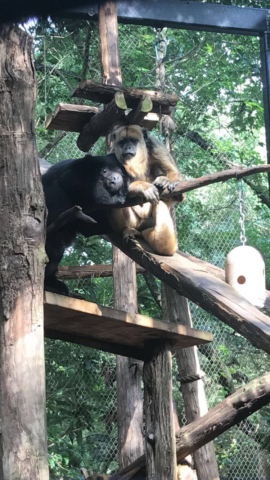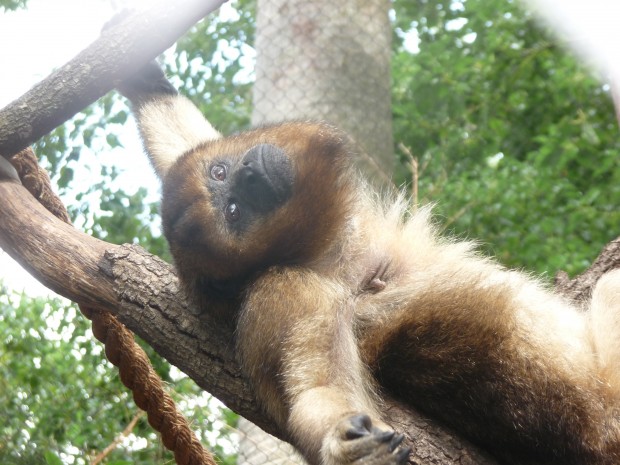Happy Howlerween – Learn About our Howler Monkeys
Written by Rachel Sorge
 One of the first animals you’ll see when you walk into our Wortham World of Primates complex at the Houston Zoo are our Black Howler Monkeys! However, you may hear them before you see them. Howler monkeys are thought to be not only the loudest primate on the planet, but possibly one of the loudest living land mammals in the world. Their garbage-disposal like call can be heard up to 3 miles away in a dense forest. Our howler monkey troop tends to start calling in reaction to the leaf blowers we have on grounds.
One of the first animals you’ll see when you walk into our Wortham World of Primates complex at the Houston Zoo are our Black Howler Monkeys! However, you may hear them before you see them. Howler monkeys are thought to be not only the loudest primate on the planet, but possibly one of the loudest living land mammals in the world. Their garbage-disposal like call can be heard up to 3 miles away in a dense forest. Our howler monkey troop tends to start calling in reaction to the leaf blowers we have on grounds.
During the month of October, the primate team at the Houston Zoo puts on a Howlerween fundraiser to help raise money for Wildtracks; an organization that cares for and rehabilitate orphaned, injured, and sick howler monkeys back into the wild.
Here at the Houston Zoo we have three howler monkeys. Vida who is 23, Garcia, who is 21, and Ramone, who is 14. Vida and Garcia were both born here in Houston, but Ramone came to us in 2012 from the Palm Beach Zoo in Florida.
Ramone is very easily distinguishable from our two girls due to his black color, while Vida and Garcia are both tan-brown in color. All howler monkeys are born a tan color to help them camouflage easily in the forest canopy, but the males develop the black color as they get older. Males are also much larger than the females.

Vida and Garcia may be difficult to tell apart by just a glance, but if you study their faces you can tell that Garcia has a much smaller and shorter face, while Vida’s face is wider and longer. Vida tends to be braver than Garcia, and is always ready to explore enrichment items or new objects placed in the exhibit by her keepers. Garcia however, likes to wait to see if new things are safe before exploring.
Our howler group has a variety of favorites that they enjoy. They will always come greet their keepers if there is a fig or hibiscus flower in hand and they react best to food enrichment when there are frozen bananas involved. The howler monkeys also really enjoy when their keepers hang up mirrors for them, because they absolutely love staring at themselves, and we don’t blame them!
A lot of our guests often wonder why our howlers are sleeping for a large portion of the day, and it’s not because they’re just lazy! In the wild, the howler monkey diet consists mostly of leaves and a small variety of fruits and nuts. Due to the lack of calories in their diet howler monkeys tend to sleep for a majority of their day, about 80%, saving their energy for the important things, like foraging for food and calling to defend their territory!
The next time you are walking through our Wortham World of Primates make sure to say hello to our trio!
